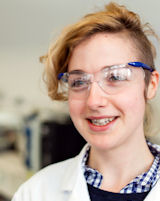You are here: Centre for Doctoral Training in Molecular-Scale Engineering > Our Students > Rebecca Smith
Rebecca Smith

Background
I graduated from the University of Sheffield with a Master of Chemistry degree in 2012. As part of my degree I spent my third year in North America at the University of Illinois at Urbana Champaign. At Illinois I undertook an undergraduate research project on heterogeneous rhenium and molybdenum based organometallic catalysts for the reduction of aqueous perchlorate. Returning to Sheffield for my fourth year Masters project, I investigated porous silver carboxylate coordination networks. The summer after graduation I went back to a different group at Illinois to work on dopant effects on titanium dioxide photocatalysts.
Previous lab experience
Most of the practical work I had done before joining the CDT was focused on inorganic and physical chemistry. This gave me both synthetic and analytical experience, using techniques such as X-ray crystallography as well as various spectroscopic and chromatographic methods.
Why I chose to study in the CDT in Molecular-Scale Engineering
I considered various conventional PhD projects in research areas I am interested in before I found the CDT. I welcomed the opportunity to gain very in depth knowledge and expertise in a single field over a number of years. I was, however, concerned that a conventional PhD would not give me the chance to learn about non-chemistry subjects I am interested in, which might in turn reduce my effectiveness as a researcher.
Probably the main thing that drew me to the CDT was the well designed course structure. It contains a good balance of taught courses, lab training and research projects over a wide variety of topics. The opportunity to do a placement in an international industrial or academic lab was also an attractive feature to me, as I found my previous time spent in the USA to be extremely valuable.
One of the key benefits of the interdisciplinary nature of the course is that, while the brief introductory courses on biology, physics and engineering topics may not have made me an expert in these fields, I now have the benefit of knowing people who are. This means that if I want to branch out into one of these areas with my research I know where to start and who to go to for advice.
Another advantage of the CDT is that it’s not a straight ‘academic apprenticeship’ like conventional PhDs. The focus on making students well rounded researchers with experience in many different disciplines will hopefully give us an advantage whether we choose an academic or industry based career.
The most enjoyable aspects
I am really enjoying the lab rotations. It’s a short amount of time so you sort of get thrown in at the deep end and have to learn quickly to be able to crack on with research. I’ve been lucky to have had a very supportive group so although it’s challenging I feel confident and motivated.
The residential week at the start of the programme was great too because I got to know the other students in my cohort much better than I probably would have done if I only saw them in lectures. We also met the students in the year above us who were really friendly and able to offer us lots of useful advice.
The most challenging aspects
Many of the taught courses have essays as part of the assessment. Having done a physical science degree, the last time I wrote an essay was at A-level, so this was a bit challenging at first. Generally the course tutors are fine with you writing them in the style of an academic article though, which made it easier for me.
Activities I participate in outside of the CDT
I’m interested in the process of turning academic research into real innovative products and university spin-out companies. I have recently taken a module with University of Sheffield Enterprise (USE, enterprise.shef.ac.uk) called the Social Innovation Lab, where I learnt about how social enterprise works and some local businesses that use this model. I’m currently working on building my own social enterprise that helps to increase collaboration between academia and industry.


